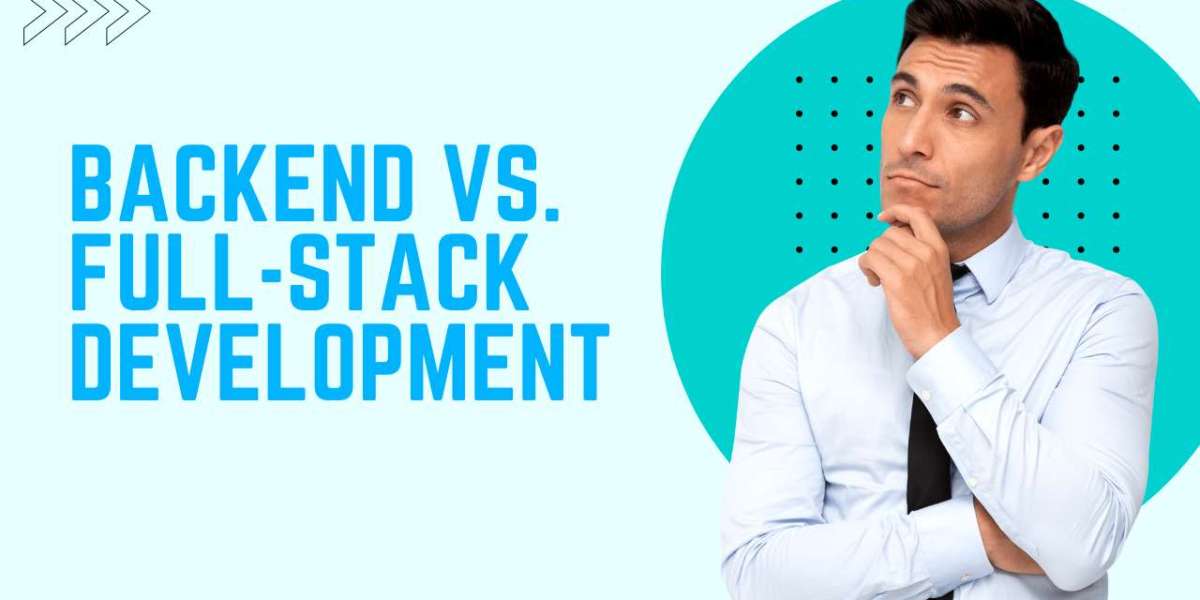In the world of software development, developers often face a critical decision: should they specialize in backend development or expand their skill set to become a full-stack developer? While both paths have their unique advantages and challenges, understanding where a language like Java fits into these roles is crucial for anyone looking to make informed career decisions. In this article, we’ll explore the differences between backend vs. full-stack development and show you how Java plays a pivotal role in both of these domains.
Before we dive deeper, it’s essential to understand some foundational concepts. If you're new to programming or need a quick refresher, check out this guide on Fibonacci series in Java, which is a great example of how algorithms are implemented in Java, helping you get a better grasp of programming logic that you will encounter in both backend and full-stack development.
Backend Development: The Core of Application Logic
Backend development, often referred to as server-side development, is the behind-the-scenes engine that powers an application. It’s responsible for managing and handling the data exchange between servers and users, authentication, and ensuring that everything runs smoothly from the backend to the frontend.
What Does a Backend Developer Do?
A backend developer is responsible for creating the logic, database management, API (Application Programming Interface) integrations, and the business logic that makes everything functional. Typically, backend development involves working with databases, managing data through server-side scripting, and handling requests from users.
Key Responsibilities of a Backend Developer:
- Building Server-Side Logic: Writing the server-side code that manages user requests, authentication, and session handling.
- Database Management: Designing and maintaining databases, such as MySQL, MongoDB, and PostgreSQL, and ensuring data is efficiently stored and queried.
- APIs and Integrations: Developing APIs for smooth communication between the frontend and backend and ensuring that third-party services can be integrated seamlessly.
- Performance Optimization: Ensuring that the backend is fast and reliable, even under heavy loads.
Java is one of the most popular backend programming languages for these tasks. It’s known for its scalability, reliability, and security features, making it the language of choice for many large-scale enterprise applications.
Why Java is a Powerful Tool for Backend Development
Java has been a staple in backend development for decades, particularly for large-scale applications and systems. Here's why it works so well in this space:
- Platform Independence: Java is designed to be platform-agnostic, meaning the same Java code can run on multiple platforms with minimal changes. This is possible because Java applications are compiled into bytecode that runs on the Java Virtual Machine (JVM).
- Scalability and Performance: Java is known for its excellent performance and scalability. It can handle high volumes of traffic, making it ideal for web applications that need to manage large amounts of data, such as banking apps, social networks, and e-commerce websites.
- Rich Ecosystem: Java has a robust set of libraries, frameworks, and tools (like Spring Boot, Hibernate, and Java EE) that make backend development efficient and scalable.
- Security Features: Java’s built-in security features, including encryption and authentication mechanisms, are crucial for developing secure backend systems.
Full-Stack Development: Bridging the Gap Between Frontend and Backend
A full-stack developer is someone who is proficient in both frontend and backend technologies. They have a well-rounded skill set that allows them to build a complete application from start to finish. While backend developers focus on server-side logic, full-stack developers are comfortable with both the client-side (what users see) and the server-side (what happens behind the scenes).
What Does a Full-Stack Developer Do?
Full-stack developers are involved in all aspects of the software development life cycle, from the user interface to the server-side components. They work on both the frontend (UI/UX) and the backend, ensuring that everything integrates seamlessly.
Key Responsibilities of a Full-Stack Developer:
- Frontend Development: Designing and building the parts of an application that users interact with directly. This involves knowledge of HTML, CSS, JavaScript, and frontend frameworks like React or Angular.
- Backend Development: Writing the server-side code, managing databases, and building APIs, similar to a backend developer’s responsibilities.
- End-to-End Application Development: Full-stack developers have the ability to create an entire application, from the user interface to the backend logic, and ensure that both layers work together smoothly.
- Database Integration: Full-stack developers also handle database design and ensure that data flows correctly between the frontend and backend.
Java’s Role in Full-Stack Development
While full-stack development traditionally requires knowledge of both frontend and backend technologies, Java continues to play a crucial role on the server-side. Java isn’t commonly used for frontend development, as languages like JavaScript dominate that space, but it is integral to full-stack development because of its versatility in building the backend architecture.
Java is commonly used in full-stack development frameworks like Spring Boot for building REST APIs, and it can easily be integrated with various frontend technologies, such as Angular, React, or Vue.js.
Key Java Technologies Used in Full-Stack Development:
- Spring Boot: One of the most popular Java frameworks for building scalable and secure backend services. Spring Boot allows developers to create production-ready applications with minimal setup, making it a go-to solution for full-stack developers.
- JavaFX or Vaadin: For developers who want to use Java for building GUI (Graphical User Interfaces) on the frontend, JavaFX or Vaadin can be an option, although these tools are less commonly used compared to modern frontend frameworks like React or Angular.
- REST APIs: Java is widely used to build REST APIs that connect the frontend with the backend. Full-stack developers use Java to ensure that these APIs are robust, efficient, and secure.
Backend vs. Full-Stack Development: Key Differences
While both backend and full-stack developers work with Java, the two roles have distinct differences in their scope of responsibilities. Here’s a comparison to help you understand where Java fits in each:
Scope of Work
- Backend Developer: Focuses only on the server-side development, writing business logic, managing databases, and creating APIs.
- Full-Stack Developer: Works on both the client-side and server-side. They’re responsible for frontend development as well as backend integration.
Skill Set
- Backend Developer: Needs to be highly skilled in server-side languages (like Java), databases, API development, and understanding system architecture.
- Full-Stack Developer: Needs to have a broader range of skills that includes knowledge of frontend technologies (HTML, CSS, JavaScript) in addition to backend technologies like Java.
Project Involvement
- Backend Developer: Typically works on the backend architecture and database, collaborating with frontend developers to ensure the frontend can retrieve and display data from the server.
- Full-Stack Developer: Works on both ends of the application, from the user interface to the server-side logic, ensuring the whole application functions as a cohesive unit.
Career Growth
- Backend Developer: Typically has a more specialized role, which can lead to roles like DevOps, Systems Architect, or Database Administrator.
- Full-Stack Developer: Has a broader career path with the ability to transition into roles such as Product Manager, Tech Lead, or Software Engineer in a variety of industries.
Why Java is a Top Choice for Both Backend and Full-Stack Developers
So, where does Java fit in the debate of backend vs. full-stack development? The answer is simple: Java is an essential part of both.
- Backend Dominance: Java remains one of the most powerful and scalable backend languages. Whether you're building RESTful APIs, integrating databases, or ensuring application security, Java’s ecosystem of frameworks and libraries make it an ideal choice for backend development.
- Full-Stack Compatibility: While Java is not used for frontend development directly, its use in backend development is a critical component of full-stack projects. The ease of integration with frontend technologies, through REST APIs and frameworks like Spring Boot, makes Java a valuable language in full-stack development.
- Enterprise-Level Applications: Java’s robustness and scalability make it the go-to choice for large-scale enterprise applications, which often require both backend and full-stack development skills.
FAQ:
Q1: What is the main difference between backend and full-stack development?
- Backend development focuses solely on server-side logic, databases, and APIs. Full-stack development covers both frontend and backend, requiring expertise in both UI/UX and server-side technologies.
Q2: Can I become a full-stack developer if I only know Java?
- Yes, but you'll need to complement your Java knowledge with frontend skills like HTML, CSS, JavaScript, and a modern framework like React or Angular.
Q3: Is Java good for backend development?
- Absolutely. Java is one of the most popular and reliable languages for backend development, known for its performance, scalability, and security features.
Q4: How does Java fit into full-stack development?
- Java is primarily used for backend development in full-stack roles. Full-stack developers can use Java to build APIs and handle server-side logic while working with frontend technologies like JavaScript to create the complete application.
Conclusion
In conclusion, Java plays a critical role in both backend and full-stack development, making it an incredibly versatile language. Whether you specialize in backend development, where Java powers server-side logic and data management, or become a full-stack developer, where Java integrates with frontend technologies through REST APIs, the language has the tools and frameworks needed to build scalable, robust applications. By mastering Java, you open doors to a wide range of development roles, from backend specialist to full-stack engineer. So, whether you're just starting out or looking to expand your career, Java is a language that will continue to serve you well in both backend and full-stack development!



